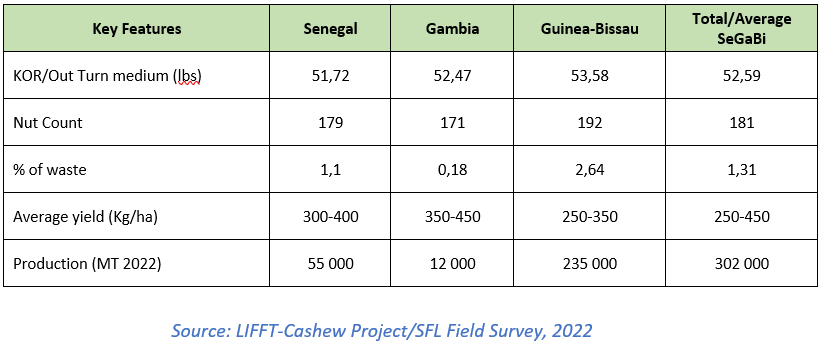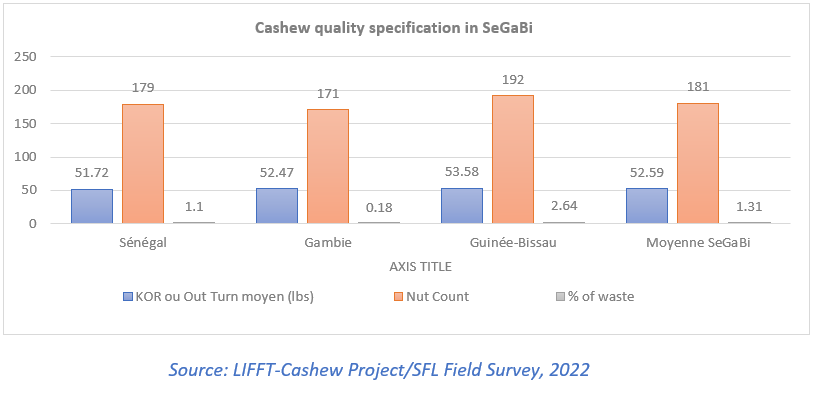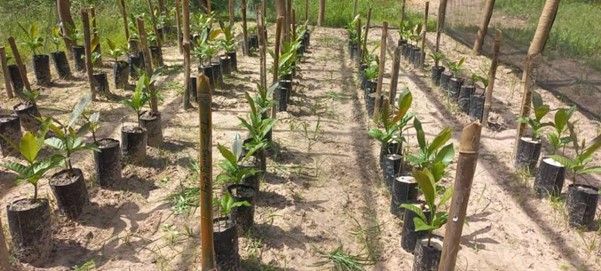Le projet LIFFT-Cashew du ministère de l’Agriculture des États-Unis (USDA), mis en œuvre par Shelter for Life International (SFL), aborde de multiples aspects de la chaîne de valeur de la noix de cajou en améliorant les liens existants et en en construisant de nouveaux pour créer un réseau régional plus intégré et durable qui améliorera la culture de la noix de cajou et la transformation et la vente des produits de la noix de cajou. Afin de rendre la chaîne de valeur plus attractive et compétitive et de développer une économie inclusive à SeGaBi, le projet LIFFT-Anacarde s’est concentré sur l’amélioration de la qualité des amandes par la formation et l’application de bonnes pratiques agricoles, l’organisation de ventes collectives et l’augmentation de la transformation locale.
C’est dans cette dynamique que le projet met l’accent sur son intervention sur deux approches essentielles visant à améliorer la productivité des arbres et la qualité des noix en renforçant les capacités des producteurs, en déterminant des cahiers des charges qualité et voyez-vous une erreur dans la mise en œuvre de mesures correctives sur le terrain et sur le long terme avec l’utilisation de variétés à fort potentiel de production, réhabilitation et/ou renouvellement des plantations.
Shelter For Life a mené une étude en 2022 pour analyser la qualité des noix produites à SeGaBi, une région où les données sur la qualité des noix sont très peu connues ou disparates. Dans ce contexte, les données qualitatives de la noix de cajou pour avoir des produits compétitifs sur le marché international est un enjeu décisif auquel est confrontée la filière anacarde dans la zone SeGaBi.
La détermination de la qualité est nécessaire car elle constitue une obligation contractuelle entre les coopératives et les transformateurs. C’est pourquoi le projet a mis en place un dispositif opérationnel nécessaire à sa mise en œuvre et à son suivi sur le terrain, qui vise à déterminer les spécifications de qualité pour chaque quantité de noix vendue d’une coopérative donnée à une unité de transformation ou à un acheteur. Plus précisément, il s’agit de déterminer i) le nombre de noix ; (ii) le virage ou le KOR ; iii) les taux de déchets.
L’étude a été réalisée sur un lot de 260 échantillons de 1 kg chacun collectés dans 90 localités dans chacun des trois pays SeGaBi de la zone d’intervention du projet et en fonction de la couverture géographique des coopératives. Sur chaque échantillon, le graining, le taux de défauts et le KOR ont été calculés.


Les résultats obtenus donnent un aperçu de la qualité des noix marquées par une discrimination spatiale des paramètres étudiés. Ces résultats de l’étude ont montré que le KOR le plus élevé a été enregistré en Guinée-Bissau. Il varie entre 52 et 53 lb avec un taux moyen de défauts de 2,64 % et un grainage de 192 noix/kg.
En Gambie, le KOR varie de 51 à 52 lbs avec un taux de défaut de 0,18% et un grainage de 171 noix/kg. La qualité la plus faible des noix par rapport à d’autres pays a été enregistrée au Sénégal, où le KOR varie entre 50 et 51 livres avec un taux de défauts de 1,1 % et un grainage de 179 noix/kg. Ces données montrent que la qualité des fruits à coque dans chacun des pays de la SeGaBi est supérieure aux normes de l’UEMOA (> soit = 50 lbs).
La qualité des noix au niveau du SeGaBi est bonne et appréciée de tous à travers le résultat ou KOR (Kernel Output Ratio), qui est une donnée très déterminante dans le commerce international de la filière anacarde. Cette performance est justifiée par la présence de gros acheteurs dans la zone, provoquant un volume d’exportation important de 95% du volume de production.
Cependant, des efforts doivent être faits dans la récolte, le conditionnement et le stockage des noix, en particulier en Guinée-Bissau, où le taux de défauts est relativement élevé, et au Sénégal, où la qualité est encore faible par rapport à d’autres régions. Le respect des bonnes pratiques est essentiel pour améliorer significativement les performances. Ainsi, la vulgarisation de ces bonnes pratiques agricoles à travers des approches telles que les champs-écoles du projet LIFFT-Anacarou, et la formation participative à travers la (ToT) Formation des Formateurs rendent cette technologie accessible à tous et sert à augmenter la qualité des noix et les revenus des producteurs adoptifs.
SFL PR/COM- BFS

